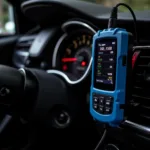Modern vehicles are technological marvels, equipped with sophisticated computer systems that monitor and control virtually every aspect of their operation. These systems generate a constant stream of data, providing valuable insights into the health and performance of your car. However, accessing this data requires a specialized tool: an OBD2 scanner, also known as an OBD2 monitor.
What is an OBD2 Monitor?
An OBD2 monitor is a device that plugs into your car’s OBD2 port, typically located under the dashboard on the driver’s side. This port acts as a gateway to your vehicle’s computer system, allowing you to access a wealth of diagnostic information. With an OBD2 monitor, you can read and clear diagnostic trouble codes (DTCs), view live sensor data, monitor engine performance, and much more.
Why You Need an OBD2 Monitor
For car owners, mechanics, and enthusiasts alike, OBD2 monitors have become essential tools. Here’s why:
-
Diagnose Car Problems: OBD2 monitors empower you to identify the root cause of car problems before they escalate. Whether it’s a check engine light, a strange noise, or decreased performance, the monitor can provide valuable clues.
-
Save Money on Repairs: By understanding the source of the issue, you can make informed decisions about repairs, potentially saving hundreds of dollars on unnecessary trips to the mechanic.
-
Improve Fuel Efficiency: Many OBD2 monitors provide real-time data on fuel consumption, allowing you to adjust your driving habits and optimize fuel efficiency.
-
Enhance Performance: Some monitors offer advanced features like performance tracking, allowing you to measure acceleration, braking, and other metrics.
Types of OBD2 Monitors
OBD2 monitors come in various types to suit different needs and budgets:
-
Basic Code Readers: These affordable devices read and clear basic DTCs, providing a starting point for diagnosing problems.
-
Bluetooth Scanners: These compact devices connect to your smartphone or tablet via Bluetooth, providing a convenient and portable solution for accessing OBD2 data.
-
Advanced Scan Tools: Professional-grade tools used by mechanics offer comprehensive diagnostic capabilities, including live data streaming, bi-directional control, and advanced coding functions.
Choosing the Right OBD2 Monitor
Selecting the right OBD2 monitor depends on your individual needs. Consider the following factors:
-
Budget: Determine how much you’re willing to spend, keeping in mind that more advanced features come at a higher cost.
-
Features: Decide which features are essential for your needs, such as code reading, live data streaming, or performance tracking.
-
Compatibility: Ensure that the monitor is compatible with your vehicle’s make, model, and year.
-
User-Friendliness: Look for a monitor with a clear display, intuitive interface, and easy-to-use software.
Conclusion
OBD2 monitors have revolutionized the way we interact with our vehicles, providing a window into their inner workings and empowering us to take control of our car maintenance and performance. Whether you’re a car enthusiast, a DIY mechanic, or simply want to stay informed about your vehicle’s health, an OBD2 monitor is an invaluable investment.


